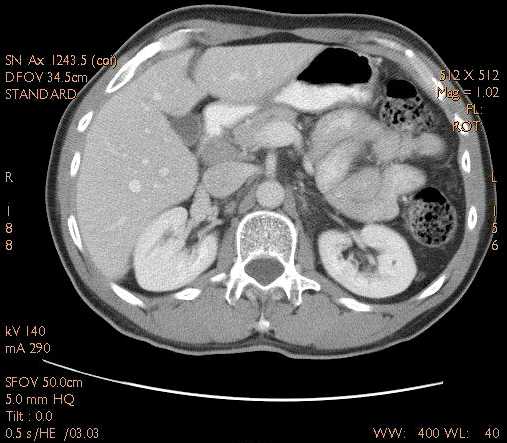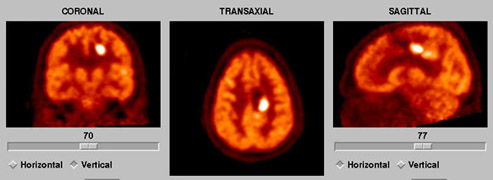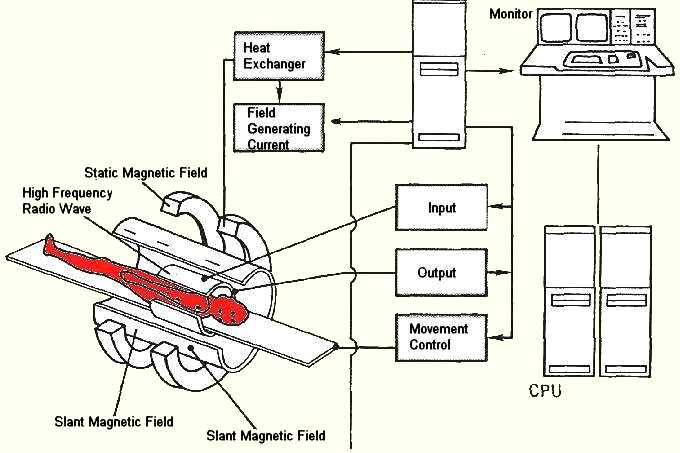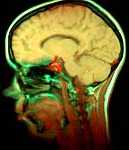Tomography (CAT, PET, MRI): What it is, what it does?
Tomography is the technique of using ultrasound, gamma rays, or X-rays to
obtaining a series of detailed pictures of areas inside the body (imaging);
the pictures are created by a computer linked to the imaging machine. The basic problem in computerized tomography is the reconstruction of a function from its line or plane integrals. Applications come from diagnostic radiology, astronomy, electron microscopy, seismology, radar, plasma physics, nuclear medicine and many other fields. More recent kinds of tomography replace the straight line model by an inverse problem for a partial differential equation.
Following is a description of some of the common types:
CT Scanner -- It is also know as CAT (Computed Axial Tomography) scan is a desired device to create images of internal structure of unrecognized object. It is a diagnostic technique in which the combined use of a computer and X rays passed through the body at different angles produces clear cross-sectional images (slices) of the tissue being examined.
The accuracy of CT image in representing a physical distribution of a
cross-sectional 2-D structure is essential. Therefore, standard and reference
for judging a CT performance is substantial.
The basic principle of focusing scanner is described in Figure 1. The center of curved array of detectors is at the locus of radiation source that emits fan-beams with a fan angle of g. The center of rotation, O, is at the middle of the line from radiation source to the central detector in the array (s = 0). The radius of image circle is defined as R = S sin(g/2),
where S is distance from source to center of rotation. The focusing
scanning produces parallel projections f from fan
projections q. The focusing principle requires a
strict relation of f = q +
s, where s indicates
orientation of a detector element from the source. The focusing scanning also
requires step sampling of fan-projection Dq = (S/R)Ds. This strict requirement ensures the sinogram forms a
square pattern in (f, xs) space, where xs = Ss, in which a
fan-projection, a set of ray-sum at certain object rotation, q, is along an inclined line (Figure 2). The fan-beam projection lies on the inclined line. The parallel projection consists of parallel ray-paths at angle of projection f. Each detector element associates with beam-width of w = S Ds.
 |
 |
 |
 |
| Figure 1. The basic principle of Focusing CT scanner set-up |
Figure 2. Sinogram mapping for Focusing CT scanner |
Figure 3. CT Scan |
Figure 4. CT Image |
This method provides clearer and more detailed information than X rays used by themselves. CT scan also has the advantage of minimizing the amount of radiation exposure. Figure 3 is a schematic of the equipments with a rotating X rays source and detector. The machine looks much like a big donut. The child is positioned in the "donut hole" and an x-ray tube will rotate around his body to generate hundreds of images, known as "slices." These images are processed by a computer to allow the doctor to see soft tissue structures in great detail. Before the scan is carried out, a contrast medium may be injected to make blood vessels, organs, or abnormalities show up more clearly; a drink of contrast medium may be given to highlight loops of intestine.
The amount of X rays absorbed by different tissues is recorded by the detector and transformed by a computer into an image.
Figure 4 shows a CT cross-section of the chest. The first CT scanner, which came into operation in 1972, was developed to study
the brain. Since the, CT brain scanning has revolutionized the diagnosis and
treatments of tumors, abscesses, and hemorrhages in the brain, as well as
strokes and head injuries. It is also invaluable in investigating disease of
any part of the trunk. It is particularly useful for locating and imaging
tumors, and for facilitating needle biopsy (removal of a sample of tissue via
a needle).
PET (Positron Emission Tomography) -- It is a diagnostic
technique based on the detection of coincidence events from electron-positron
annihilation, which converts the masses to two 511 Kev X-rays moving in
opposite directions (see Figure 5). Before performing the scan, substances
that take part in biochemical processes in the body are labeled with
radioisotopes ( such as carbon 11, nitrogen 13, or oxygen 15).
 |
 |
These
substances are injected into the blood-stream and are taken up in greater concentrations by areas of tissue that are more metabolically active. In the tissue, the substances emit positrons, which, in turn, release X-rays. It is the detection of these X-rays that actually forms the basis of PET scanning. By
surrounding the patient with an array of detectors linked to a computer, the origin of the X-rays can be computed and a picture built of the
distribution of the radio- active isotopes. Figure 6 is a sample of the
PET brain scan. PET scanning is particularly
valuable for investigating the brain. |
|
Figure 5. PET Scan |
Figure 6. PET Image |
|
It is used for detecting tumors, for locating the origin of epileptic activity within the brain, and for examining brain function in various mental illnesses. PET images are different from those obtained from more routine imaging equipment, such as X-Ray, CT, Ultrasound, or MRI as these scans show what the tissues look like whereas P.E.T. studies contain information about tissue function and metabolism. This technique has a serious drawback in that it requires an injection of radioactive marker. The dose is tiny but, for safety, no one person is generally allowed to have more than one scanning session a year. The most commonly used radiopharmaceutical, Fluorine deoxyglucose (FDG) demonstrates where metabolism of glucose is occurring in the body, including malignant cells. There are other radiopharmaceuticals that demonstrate other aspects of metabolism, but they are less commonly used at the present time.
P.E.T. produces images of the body that represent the functional rather than anatomical characteristics of disease, resulting in the early detection of many abnormalities that are undetected using conventional X-Rays, CT, or MRI scans.
MRI (Magnetic Resonance Imaging) -- It is sometimes called NMR (Nuclear Magnetic Imaging). MRI is a diagnostic technique that provides high-quality cross-sectional or three dimensional images of organs and
structures within the body without using X rays or other radiation. During the imaging, the patient lies inside a massive hollow cylindrical magnet (see
Figure 7). The nuclei (protons) of the body's hydrogen atoms normally point in random directions. In a magnetic field, however, these atoms line up parallel to each other. If the hydrogen nuclei are then knocked out of alignment by a strong pulse of radio waves, they produce a detectable radio signal as they fall back into alignment.
 |
 |
Magnetic field
gradient is required to translates the signals into separate spatial locations. Magnetic coils in the machine detect these signals and a
computer changes them into a cross-sectional or three dimensional image
based on the strength of signal produced by different types of tissue.
Tissues that contain a lot of hydrogen (such as fat) produce a bright
image; those that contain little or no hydrogen (such as bone) appear
dark. Figure 8 is a MRI image of the head. MRI provides clear images of tumors of the brain and spinal cord. |
|
Figure 7. MRI Scan |
Figure 8. MRI Image |
|
Also shown clearly by MRI is the internal
structure of the eye and ear. MRI can produces detailed images of the heart
and major blood vessels, provides images of blood flow, and is useful for
examining joints and soft tissues. Functional Magnetic Resonance Imaging
(fMRI) is a technique for determining which parts of the brain are activated
by different types of physical sensation or activity, such as sight, sound or
the movement of a subject's fingers. This "brain mapping" is achieved by
setting up an advanced MRI scanner in a special way so that the increased
blood flow to the activated areas of the brain shows up on Functional MRI scans. fMRI
is proving to be the most rewarding of scanning techniques, but it is
phenomenally expensive. For this reason a lot of experimental work is still
done by the older technique of PET. Neurosurgeons use a MRI scan not only in defining brain anatomy but also in evaluating the integrity of the spinal cord after trauma. It is also used when considering problems associated with the vertebrae or intervertebral discs of the spine. A MRI scan can evaluate the structure of the heart and aorta, where it can detect aneurysms or tears. It provides valuable information on glands and organs within the abdomen, and accurate information about the structure of the joints, soft tissues, and bones of the body. Often, surgery can be deferred or more accurately directed after knowing the results of a MRI scan.
See more information about tomography's mathematics on this Web Site





